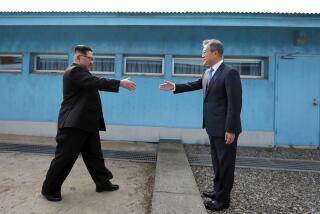Sun Myung Moon dies at 92; led controversial Unification Church
The Rev. Sun Myung Moon, the self-proclaimed Messiah from South Korea who led the Unification Church, one of the most controversial religious movements to sweep America in the 1970s, has died. He was 92.
Moon, who had been hospitalized with pneumonia in August, died Monday at a hospital in Gapyeong, South Korea, church officials announced.
Although greeted as a Korean Billy Graham when he arrived in the United States four decades ago, Moon gradually emerged as a religious figure with quite different beliefs, whose movement was labeled a cult and whose followers were mocked as âMoonies.â At the height of his popularity, he claimed 5 million members worldwide, a figure that ex-members and other observers have called inflated. Those numbers are believed to have fallen into the thousands today.
Moon offered an unorthodox message that blended calls for world peace with an unusual interpretation of Christianity, strains of Confucianism and a strident anti-communism. He was famous for presiding over mass marriage ceremonies that highlighted Unificationâs emphasis on traditional morality.
What also made Moon unusual was a multinational corporate vision that made him a millionaire many times over. He owned vast tracts of land in the U.S. and South America, as well as dozens of enterprises, including a ballet company, a university, a gun manufacturer, a seafood operation and several media organizations, most notably the conservative Washington Times newspaper. He also owned United Press International.
Moon was âthe object of more suspicion and enmity than almost any other contemporary religious leader,â Eileen Barker, an authority on the Unification Church and new religions at the London School of Economics, wrote some years ago.
The short, balding immigrant evangelist was not charismatic in the usual sense. He spoke poor English and gave few interviews. His sermons, delivered through interpreters, rambled on for hours and often exhorted followers against using âlove organsâ in promiscuous behavior or homosexual relationships.
His ideas often seemed bizarre: He believed in numerology, proposed building a highway around the world and for a while embraced a Zimbabwean man as the reincarnation of a son who had died in an accident.
He courted the powerful with surprising success, at one time counting among his friends and allies Christian right leader Jerry Falwell, who defended Moon when he was tried and later convicted in the U.S. on charges of tax evasion; the Nation of Islamâs Louis Farrakhan, who shared pulpits with him; and former President George H.W. Bush, who appeared at Unification Church-affiliated events in the U.S. and abroad.
In 2004, Moon invited guests to a U.S. Senate office building in Washington, where he had himself crowned ânone other than humanityâs Savior, Messiah, Returning Lord and True Parent.â The ceremony was attended by a dozen members of Congress, several of whom later told reporters they had been misled about the purpose of the event.
His religious journey purportedly began 16 years after his birth on Jan. 2, 1920, in what is now North Korea. According to biographical accounts, Jesus appeared to the young Moon on a Korean mountaintop on Easter Sunday in 1936. From this meeting Moon divined that his job was to complete Jesusâ mission of creating heaven on Earth.
During high school in Korea and at Waseda College in Tokyo, where he studied electrical engineering, Moon claimed to receive more messages from spiritual figures, including Buddha and Moses. He later said that Buddha told him to seek the unification of world religions âin a common effort to salvage the universe.â
After World War II, Moon founded a church and began preaching full-time, often speaking out against communism. His strong political stands caused problems with the North Korean government, which jailed him on charges of bigamy and draft evasion. He was freed in 1950.
In 1954, he founded the Holy Spirit Assn. for the Unification of World Christianity in Seoul. Three years later he published âThe Divine Principle,â the main text of his church.
Unification theology is complex, but a central tenet is to right the wrongs of Adam and Eve. According to the Divine Principle, Satan seduced Eve, who then had illicit relations with Adam and spawned impure children.
Moon regarded Jesus as the second Adam, but Jesus was crucified before he could marry and bring forth sinless progeny. Thus, according to Moon, mankindâs salvation depended on a third savior to appear on Earth and marry a pure woman. Together they would become the âtrue parentsâ of mankind and beget pure families to populate the kingdom of God.
The new Christ, Moon prophesied, would be born in Korea.
Moonâs beliefs did not go over well with leaders of mainline Christianity. He was turned down when he applied for membership to the major ecumenical organizations, the National Council of Churches and the World Council of Churches.
âHis theology was heretical,â said David Bromley, a Virginia Commonwealth University sociologist who co-authored âMoonies in America,â a major study of the Unification movement during its peak in the 1970s.
Church members addressed Moon and his wife, Hak Ja Han, as the âTrue Parents,â a title that outraged many of the actual parents of Moonâs followers. The Moons moved to the U.S. in 1971 and eventually lived in a 35-room mansion on an estate in Irvington, N.Y.
Moonâs first marriage, to Choe Sung-kil, ended in divorce in 1957. He had a son with her and another with Kim Myung-hee, who lived with Moon during the 1950s. In 1960 he married Han, then a young disciple. They had 14 children, of whom 10 survive him. He was believed to have more than 40 grandchildren and numerous great-grandchildren.
Had Moon restricted his recruiting to ethnic Koreans, he might have avoided criticism, Bromley said. But the church began targeting white middle-class youths on or near college campuses, a tactic also pursued by two other sects that attained notoriety in the 1970s, the Children of God and the Hare Krishnas.
An anti-cult movement rose in opposition to the groups and created a market for âdeprogrammersâ who abducted church members and tried to reverse the brainwashing they believed was fundamental to the cultsâ influence.
Moon promoted interracial and intercultural marriages and arranged thousands of unions. Couples matched by the church were instructed to refrain from having intercourse for 40 days, partly to ensure that the unions were based on âpure loveâ rather than carnal desire. In one of the churchâs most publicized events, Moon blessed 6,500 couples in New Yorkâs Madison Square Garden in 1988.
Followers were expected to live communally under austere conditions, although the church later moved away from group living as members matured and started their own families. Each member also was expected to raise money for the church, often by peddling flowers or other innocuous items at airports and shopping malls.
In 1978 Congress investigated the church as part of a broader probe into Korean influence-buying. A congressional subcommittee concluded that Moonâs organization had violated U.S. tax, immigration, banking and currency laws. In 1982 he was convicted on tax evasion charges and served 11 months in a federal prison in Danbury, Conn.
That year, he launched the Washington Times, which positioned itself as a conservative alternative to the Washington Post. It won loyal readers in the White House and among conservative strategists but has been a chronic money-loser, surviving on more than $2 billion in subsidies from the church. Circulation fell to about 40,000 daily copies in 2010, when a family feud caused the patriarch to repurchase the paper after having given control of it four years earlier to his eldest son, Preston.
Times special correspondent Jung-yoon Choi in Seoul contributed to this report.
More to Read
Sign up for Essential California
The most important California stories and recommendations in your inbox every morning.
You may occasionally receive promotional content from the Los Angeles Times.











